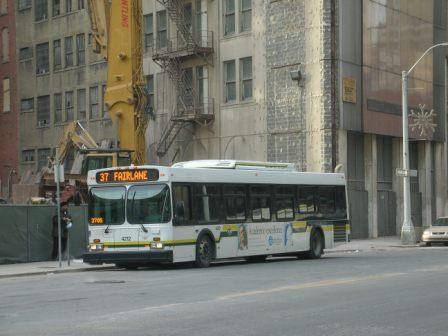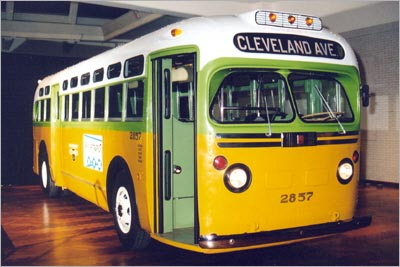I’ve been to Detroit a total of four times–each time accompanied by Bus Nerd. Except for the second trip, when we stayed downtown and practiced getting around solely by bus, our visits have involved a fair amount of car use. His parents, though bus chick sympathizers, are not bus riders themselves, and since we usually go there to visit them, we roll how they roll. And then there’s the fact that Detroit is the most transit-poor major city I have ever visited.
In Seattle, folks tend to be surprised if you use the bus as your primary form of transportation. In Detroit, they are surprised if you use the bus at all. It’s not that people in Detroit don’t ride buses (the buses we’ve ridden there have been pretty full); it’s that people who have a choice don’t ride buses. As I’ve mentioned before, the bus-stop signs don’t even tell you which routes stop there. There are no schedules, and maybe that’s a good thing, since (so residents say) buses are regularly very late. Sometimes (as I learned on my second visit), they don’t come at all. The trip planner on DDOT’s website worked for us on one of our previous trips, but when we tried to use it last Sunday, it was down. I’ve tried using it since I’ve been home. Still down.

A Detroit city bus
Many factors have contributed to the state of Detroit’s transit system:
1) The Big Three: These guys have been undermining and outright blocking efforts to create real transit in the region for decades. They sell the heck out of car culture, and it’s working. It also doesn’t hurt that almost everyone who lives there is employed by the industry (assuming they’re employed at all), and they are justifiably proud of what they produce.
2) Sprawl: Detroit is a huge, spread-out city with no real central point of commerce. Many (maybe most) of its employment and commercial centers are in surrounding suburbs. As I learned in Houston, planning routes and transfer points under these conditions is a challenge.
3) Poor environment for pedestrians: Let’s just say that walking around in the Motor City made me long for Montlake.
4) Two systems that don’t play well together: The Detroit Department of Transportation (DDOT) runs the city buses, but Suburban Mobility Authority for Rapid Transit (SMART) runs the buses in the suburbs, including buses that go from the suburbs to Detroit. Individual cities elect to participate in SMART, and some (Livonia, for example) have elected not to. This means no bus service whatsoever for the residents of those cities.
5) Racism: Detroit is one of the most segregated metropolitan areas in the country. The city is predominantly black, and the suburbs are predominantly (often, exclusively) white. Many suburban cities see transit as a threat (don’t want the “blacks from Detroit” to have an easy way to get there), so they don’t support it.
6) Weather: (Bus Nerd will disagree with me on this one.) It’s simply too dang cold to be standing outside in the winter.
Some reasons for hope:
1) Recent efforts to build a light rail line between Detroit and Ann Arbor: This would provide easy access to U of M and stop at the airport on the way.
2) Transportation Riders United: This is a very cool transit advocacy organization that is working hard on the light rail issue and also happens to have its offices in my very favorite Detroit building.
3) Post Super Bowl transit talks: During the Super Bowl, DDOT ran free shuttles from the suburbs and various neighborhoods to the festivities downtown. Lots of people–visitors, suburbanites, and Detroiters–used them, proving that folks will take advantage of options that are useful and convenient. It looks like city officials are starting to see the value.
4) Rosa Parks Transit Center: It’s in progress as I type and will have lots of cool features (for example, a climate-controlled waiting area) I’d like to see here.
And speaking of Miss Rosa (who, me?) … Detroit is also home to the bus she was riding on the day she become my shero.

